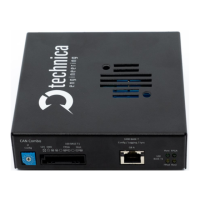4.5.1.2 Enable Traffic Shaping and Traffic Bandwidth [%]
Traffic Shaping is enabled. And it is possible to set a maximum Traffic Bandwidth,
the data is sent on the logging port. This is always valid for the 100BASE-T1 port
and GB-port. It cannot be configured separately.
For example, a Traffic Bandwidth of 40% means the maximum bandwidth, the
logged frames are sent to a logging device, connected on the 100BASE-T1 port
and/or GB-A port, is 40% of the maximum bandwidth of the specific port. (40Mbit/s
on the 100BASE-T1 port and 400Mbit/s on the GB-A port)
Traffic Shaping is deactivated, and Traffic Bandwidth is not configurable. The data
will be sent as fast as possible.
Note: The average input must not be higher than the average bandwidth on the logging
ports.
4.5.1.3 Destination MAC
Here you can configure the MAC-destination of the TECM protocol header. Default
Value is 01:00:5E:00:00:00.
4.5.1.4 Enable Packetization [ms], Timeout for Packetization
Packetization is enabled
Packetization is disabled
Packetization means, that more than one logged CAN-message is packed in one
TECMP frame. The maximum is limited by the number of bytes or the Timeout for
packetization. If one limitation is reached, the TECMP frame is sent out through the
logging port.
Maximum is 700 bytes for the payload of the TECMP frame.
Values for Timeout [ms] can be between 100ms and 65535ms.
4.5.1.5 Logging Ports for Packetization
Here you define, which port is using packetization.
GB-A is using packetization
GB-A is using no packetization
Note: Only one port can use packetization at the same time.

